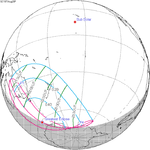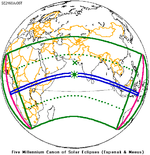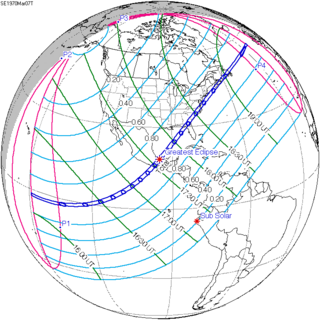Solar eclipse of March 7, 1970
| Solar eclipse of March 7, 1970 | |
|---|---|
| Type of eclipse | |
| Nature | Total |
| Gamma | 0.4473 |
| Magnitude | 1.0414 |
| Maximum eclipse | |
| Duration | 208 s (3 min 28 s) |
| Coordinates | 18°12′N 94°42′W / 18.2°N 94.7°W |
| Max. width of band | 153 km (95 mi) |
| Times (UTC) | |
| Greatest eclipse | 17:38:30 |
| References | |
| Saros | 139 (27 of 71) |
| Catalog # (SE5000) | 9442 |
The total solar eclipse of March 7, 1970 was visible across all of North America and Central America. A solar eclipse occurs when the Moon passes between Earth and the Sun, thereby totally or partly obscuring the image of the Sun for a viewer on Earth. A total solar eclipse occurs when the Moon's apparent diameter is larger than the Sun's, blocking all direct sunlight, turning day into darkness. Totality occurs in a narrow path across Earth's surface, with the partial solar eclipse visible over a surrounding region thousands of kilometres wide. Totality was visible across southern Mexico and across the southeast coast of the United States and Canada. Greatest eclipse occurred over Mexico, with totality lasting 3 minutes and 28 seconds. Totality over the United States lasted up to 3 minutes and 10 seconds.[1] There will not be an eclipse with a greater duration of totality over the contiguous United States until the solar eclipse of April 8, 2024, a period of 54 years.
Scientific effects
The March 7 eclipse slowed a radio transmission of atomic time from North Carolina to Washington, D.C.[2]
Images

Animation of eclipse path (3 minutes per frame)
Related eclipses
Solar eclipses of 1968-1971
This eclipse is a member of a semester series. An eclipse in a semester series of solar eclipses repeats approximately every 177 days and 4 hours (a semester) at alternating nodes of the Moon's orbit.[3]
The partial solar eclipse on July 22, 1971 occurs in the next lunar year eclipse set.
| Solar eclipse series sets from 1968 to 1971 | ||||||
|---|---|---|---|---|---|---|
| Ascending node | Descending node | |||||
| Saros | Map | Gamma | Saros | Map | Gamma | |
| 119 | March 28, 1968 Partial |
−1.037 | 124 | September 22, 1968 Total |
0.9451 | |
| 129 | March 18, 1969 Annular |
−0.2704 | 134 | September 11, 1969 Annular |
0.2201 | |
139 Totality in Williamston, NC USA |
March 7, 1970 Total |
0.4473 | 144 | August 31, 1970 Annular |
−0.5364 | |
| 149 | February 25, 1971 Partial |
1.1188 | 154 | August 20, 1971 Partial |
−1.2659 | |
Saros 139
This eclipse is a part of Saros series 139, repeating every 18 years, 11 days, and containing 71 events. The series started with a partial solar eclipse on May 17, 1501. It contains hybrid eclipses from August 11, 1627 through December 9, 1825 and total eclipses from December 21, 1843 through March 26, 2601. There are no annular eclipses in this set. The series ends at member 71 as a partial eclipse on July 3, 2763. Its eclipses are tabulated in three columns; every third eclipse in the same column is one exeligmos apart, so they all cast shadows over approximately the same parts of the Earth.
The longest duration of totality will be produced by member 61 at 7 minutes, 29.22 seconds on July 16, 2186. This date is the longest solar eclipse computed between 4000 BC and AD 6000.[4] All eclipses in this series occur at the Moon’s ascending node of orbit.[5]
| Series members 18–39 occur between 1801 and 2200: | ||
|---|---|---|
| 18 | 19 | 20 |
 November 29, 1807 |
 December 9, 1825 |
 December 21, 1843 |
| 21 | 22 | 23 |
 December 31, 1861 |
 January 11, 1880 |
 January 22, 1898 |
| 24 | 25 | 26 |
 February 3, 1916 |
 February 14, 1934 |
 February 25, 1952 |
| 27 | 28 | 29 |
 March 7, 1970 |
 March 18, 1988 |
 March 29, 2006 |
| 30 | 31 | 32 |
 April 8, 2024 |
 April 20, 2042 |
 April 30, 2060 |
| 33 | 34 | 35 |
 May 11, 2078 |
 May 22, 2096 |
 June 3, 2114 |
| 36 | 37 | 38 |
 June 13, 2132 |
 June 25, 2150 |
 July 5, 2168 |
| 39 | ||
 July 16, 2186 | ||
Metonic series
The metonic series repeats eclipses every 19 years (6939.69 days), lasting about 5 cycles. Eclipses occur in nearly the same calendar date. In addition, the octon subseries repeats 1/5 of that or every 3.8 years (1387.94 days). All eclipses in this table occur at the Moon's ascending node.
| 22 eclipse events between December 24, 1916 and July 31, 2000 | ||||
|---|---|---|---|---|
| December 24–25 | October 12 | July 31–August 1 | May 19–20 | March 7 |
| 111 | 113 | 115 | 117 | 119 |
 December 24, 1916 |
 July 31, 1924 |
 May 19, 1928 |
 March 7, 1932 | |
| 121 | 123 | 125 | 127 | 129 |
 December 25, 1935 |
 October 12, 1939 |
 August 1, 1943 |
 May 20, 1947 |
 March 7, 1951 |
| 131 | 133 | 135 | 137 | 139 |
 December 25, 1954 |
 October 12, 1958 |
 July 31, 1962 |
 May 20, 1966 |
 March 7, 1970 |
| 141 | 143 | 145 | 147 | 149 |
 December 24, 1973 |
 October 12, 1977 |
 July 31, 1981 |
 May 19, 1985 |
 March 7, 1989 |
| 151 | 153 | 155 | ||
 December 24, 1992 |
 October 12, 1996 |
 July 31, 2000 | ||
In popular culture
Carly Simon’s December 1972 pop hit “You’re So Vain” contains the lyric “Then you flew your Learjet up to Nova Scotia to see the total eclipse of the sun,” and *may* have been a reference to this eclipse, as opposed to the one also over Nova Scotia on July 10, 1972, because Simon first began writing the lyrics in 1971. However, it remains feasible that she may have known of the latter in advance and realized that it would’ve been in the news some months previously by the time the song was actually released. For practical reasons, it’d be more feasible for the wealthy vain subject of the song to have flown a Learjet to Nova Scotia for the 1972 eclipse because the 1970 one was visible in parts of the USA and Mexico where it was longer lasting and a much more pleasant climate to watch an eclipse from than Nova Scotia would’ve been in early March, so he would’ve been much more likely to travel to one of those places. For the 1972 eclipse, on the other hand, Nova Scotia was the southernmost land mass along the totality path, so it would’ve been the best and most accessible place from which to watch it (most of the rest of the path was in the cold [even in July] lands of northeastern Siberia, northern Alaska, the northernmost tip of the Yukon Territory, the Northwest Territories and present-day Nunavut (which hadn’t been split off from the Northwest Territories yet). Since this one was in July, Nova Scotia would’ve been considerably more pleasant climate-wise than it would’ve been in early March.
This may also have been the eclipse mentioned in episode two of the The Mary Tyler Moore Show (1970–77), entitled "Today I am a Ma'am", which the character Howard Arnell (played by Richard Schaal (1928 - 2014)) has photographs he took of it pre exposed and therefore ruined, whereupon he bemoans the fact that the next total eclipse over Minneapolis will not occur until the solar eclipse of September 14, 2099, although a partial would happen in 1979.
Notes
- ^ Espenak, Fred. "TOTAL SOLAR ECLIPSE OF 1970 MAR 07". NASA Eclipse Website. Goddard Space Flight Center. Retrieved 3 June 2014.
- ^ Sadeh, D. (1971), Phase variation of a very accurate radio frequency signal due to the solar eclipse, J. Geophys. Res., 76(34), 8427–8429, doi:10.1029/JA076i034p08427
- ^ van Gent, R.H. "Solar- and Lunar-Eclipse Predictions from Antiquity to the Present". A Catalogue of Eclipse Cycles. Utrecht University. Retrieved 6 October 2018.
- ^ Ten Millennium Catalog of Long Solar Eclipses, −3999 to +6000 (4000 BCE to 6000 CE) Fred Espenak.
- ^ "NASA - Catalog of Solar Eclipses of Saros 139". eclipse.gsfc.nasa.gov.
References
- Earth visibility chart and eclipse statistics Eclipse Predictions by Fred Espenak, NASA/GSFC
Maps:
News:
Photos and observations
- Russia expedition
- Foto Solar eclipse of March 7, 1970
- Solar Eclipse Photo Gallery 1 1970-1984, Photographs by Fred Espenak, from Windsor, NC
- Observations of coronal polarization at the solar eclipse of 7 March, 1970 Polarigraphic observations of the 7 March 1970 eclipse were made at Miahuatlán (Mexico)
- Solar Eclipse of March 7, 1970 Williamston, NC by Gerard M Foley




